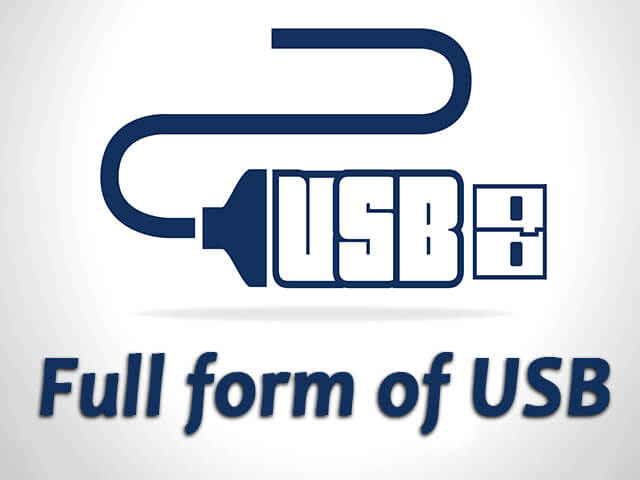USB full form
The USB port is the most widely used port of a computer which is used to connect various devices to computers. USB refers to industry standards mainly created for communication and interfacing of two computers or a computer and another device. USBs are created with the purpose of Data transfer and electricity supply between devices such as keyboards – mouse, printers, portable media players, disk drives, etc.
What is the Full Form of USB in Computer Language

The full form of USB.
| Letter | Stands for |
| U | Universal |
| S | Serial |
| B | Bus |
History of USB
USB was invented in 1994 by a joint effort of seven companies. These companies are Microsoft, Compaq, Intel, Nortel, DEC, IBM, and NEC. Different Operating systems like Windows, Mac, and Linux support USB devices.
Nowadays the parallel and serial ports of computers are replaced by USB ports. Because USB ports are more compatible and have a faster speed of data transfer.
USB is a hot-swappable technology which means it can be added or removed from the computer without restarting the computer.
USB is also called plug and play because to add a USB device to the computer you just have to insert a USB device into the USB port. The computer will automatically read it and install the necessary driver you do not have to do anything.
Features of USB
- At most 127 Peripherals can be connected to a single USB host controller
- The Maximum Data Transfer speed of a USB device is 480Mbps (for USB 2.0)
- A USB Cable which is without a hub can be 5 meters long. And with the hub, it can be 40 meters long.
- USB acts as Plug and play device
- For USB devices there is no need for an additional power supply, as they can draw power directly from the USB interface.
- When a computer turns into power-saving mode USB automatically converts into “Sleep” mode.
Versions and connectors of USB
Depending upon the Data Transmission speed there are a total of 8 versions of USB.
1) USB 1.0, 2) USB 1.1, 3) USB 2.0, 4) USB 3.0, 5) USB 3.1, 6) USB 3.2, 7) USB 4
- USB 1.0 gives a maximum data transmission speed of 1.5Mbps.
- USB 1.1 gives a maximum data transmission speed of 12Mbps.
- USB 2.0 gives a maximum data transmission speed of 480Mbps.
- USB 3.0 gives a maximum data transmission speed of 5Gbps.
- USB 3.1 gives a maximum data transmission speed of 10Gbps.
Depending upon the size the USB are classified into three types
- Standard USB A, B, and C:
- USB-A: This is the most commonly found USB. It is mostly used for computers, smartphones, keyboards, and mice. Type-A USB is present at one end of all most USB cables. This type of USB can go into the port only one way.
- USB-B: These are the most rarely used USBs. They are mostly used to connect printers and scanners to computers
- USB-C: This is the most recent technology in the field of USB. All-new mobile gadgets nowadays come with a USB-C type port.USB-C allows faster Data transfer and charging of smartphones. You can connect USB-C either way around hence they are reversible.
2. Mini size USB: This USB was used to connect old small devices such as Mp3players cameras and mobile phones to host.
3. Micro USB: Micro USB is also very common. Using this type of connection you can connect external Hardisk, Flash drives and Memory sticks directly to the mobile devices.
Depending upon the speed of data transmission and size of the USB there is a total of 11 connectors that are used all over the world.
Advantages of USB
- Low Electricity consumption.
- Highly Portable each device containing a USB port fits in with a USB.
- A very large variety of different sizes of USB connectors are available.
- USB has cheaper in price.
Disadvantages of USB
- Data transmission is not as fast as other systems of data transmission.
- USB cables are limited in length.
- Broadcasting features are not available on USB. Only individual massages can be exchanged between host and peripherals devices.
FAQ About USB
Ans: The long form of USB is Universal Serial Bus.
Ans: The USB was invented in 1994.
Ans: These companies are Microsoft, Compaq, Intel, Nortel, DEC, IBM, and NEC
Ans: The maximum data transfer speed for a USB device is 480Mbps.
Ans: The total of 127 Peripherals can be connected using a single USB host controller.



